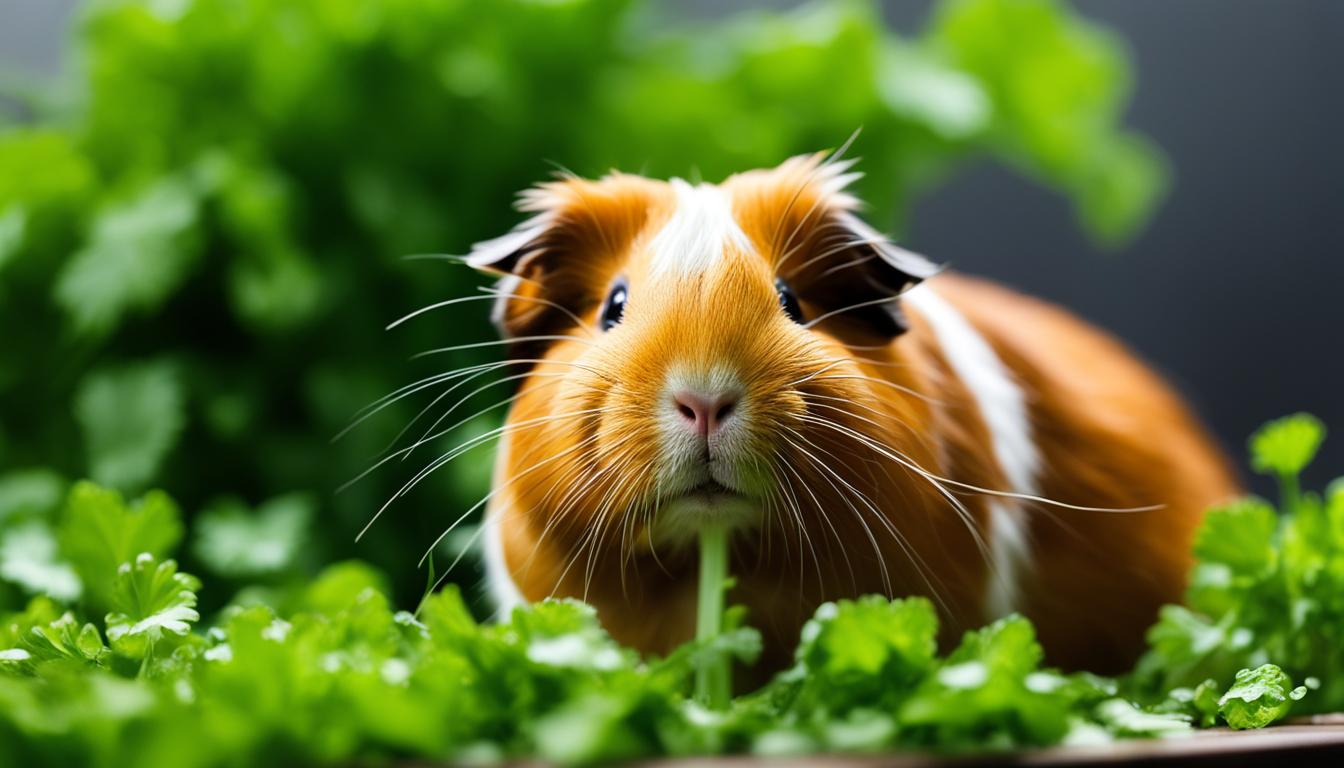Greetings, guinea pig enthusiasts! Are you curious about whether your furry friend can munch on cilantro leaves?
Well, you’ve come to the right place! In this comprehensive guide, we’ll explore the relationship between guinea pigs and cilantro, discuss its nutritional benefits, and provide tips on how to incorporate it into their diet. Let’s dive in!
Key Takeaways:
- Cilantro is safe for guinea pigs to eat, but should be given in moderation.
- It is high in vitamins C, A, and K, which promote overall health.
- Guinea pigs should primarily consume hay, with cilantro making up a small portion of their diet.
- Before feeding cilantro, wash it thoroughly and remove any yellowed or wilted leaves.
- Introduce cilantro gradually and monitor your guinea pig’s reaction to ensure it agrees with their digestive system.
The Health Benefits of Cilantro for Guinea Pigs
Cilantro, also known as coriander, offers several health benefits for guinea pigs. This leafy herb is packed with essential vitamins such as vitamin C, vitamin A, and vitamin K, which are all vital for maintaining optimal guinea pig health.
Vitamin C is especially important for guinea pigs as they cannot produce it themselves. This vitamin boosts their immune system, aids in wound healing, and helps prevent diseases like scurvy.
Cilantro is a great natural source of vitamin C, ensuring that your guinea pig gets the necessary dose of this crucial nutrient.
Vitamin A, found in abundance in cilantro, plays a role in promoting good eyesight and overall growth in guinea pigs.
It supports the health of their skin and mucous membranes, keeping them functioning properly. Additionally, cilantro contains vitamin K, which is vital for maintaining healthy teeth and bones in guinea pigs.
It’s important to note that while cilantro provides numerous health benefits, it should be given in moderation.
Guinea pigs have specific dietary needs, and an excessive intake of cilantro may disrupt the balance of their nutritional requirements.
As with any food, it’s best to introduce cilantro gradually into your guinea pig’s diet and monitor their reaction to ensure it agrees with them.
How Much and How Often to Feed Cilantro to Guinea Pigs
When it comes to adding cilantro to your guinea pig’s diet, it’s important to do so in moderation. Guinea pigs should primarily consume hay as their main food, with only about 10% of their diet consisting of fresh fruits and vegetables.
This means that cilantro should be included as part of this 10% and not as a main staple.
A few sprigs of cilantro can be fed to your guinea pig a couple of times a week. This allows them to enjoy the nutritional benefits of cilantro without overfeeding them.
It’s also important to monitor your guinea pig’s reaction to cilantro and ensure that it does not cause any digestive issues.
Introducing cilantro gradually is also recommended, especially if your guinea pig is not accustomed to it.
Serve the cilantro on its own, without other familiar foods, to increase the likelihood of your guinea pig trying it.
This will help you determine if your guinea pig enjoys the taste of cilantro or if it’s not their preference.
Table: Frequency and Quantity of Cilantro for Guinea Pigs
| Frequency | Quantity |
|---|---|
| A couple of times a week | A few sprigs |
By following these guidelines, you can ensure that your guinea pig receives the benefits of cilantro as a treat without compromising their overall diet.
dRemember to always prioritize hay as their main food source and consult with a veterinarian for any specific dietary recommendations for your guinea pig.
Preparing Cilantro for Guinea Pigs

Before feeding cilantro to your guinea pig, it is important to properly prepare it to ensure their safety and enjoyment. Here are some steps to follow:
Washing Thoroughly:
Start by washing the cilantro thoroughly under running water to remove any dirt, pesticides, or other impurities. This step is crucial to keep your guinea pig safe and healthy.
Discarding Yellowed or Wilted Leaves:
Next, carefully examine the cilantro leaves and discard any that are yellowed or wilted. These leaves may have lost their nutritional value and could potentially be harmful to your guinea pig.
Serving with Stems:
Guinea pigs can enjoy eating cilantro stems, so there’s no need to remove them. Simply chop the cilantro into small, manageable pieces and serve it to your furry friend.
It’s worth noting that guinea pigs can also eat the flowers of cilantro, which adds a nice touch to their dining experience.
However, it is important to avoid feeding them the seeds (coriander) and roots, as these parts can be less safe for their consumption.
Table: Do’s and Don’ts of Preparing Cilantro for Guinea Pigs
| Do | Don’t |
|---|---|
| Wash cilantro thoroughly | Feed yellowed or wilted leaves |
| Serve cilantro with stems | Give them the seeds (coriander) |
| Include cilantro flowers | Offer them the roots |
Do Guinea Pigs Like Cilantro?
When introducing cilantro to a guinea pig’s diet, it’s important to consider their individual tastes. While some guinea pigs may enjoy the sharp and herby flavor of cilantro, others may find it too strong.
To increase the likelihood of your guinea pig trying cilantro, it is advisable to introduce it gradually and serve it on its own, without other familiar foods.
Cilantro can be offered as a treat for guinea pigs, providing a refreshing change from their regular hay and pellets.
Some guinea pigs may take to it immediately, while others may need some time to warm up to the taste.
It’s important to monitor your guinea pig’s reaction to cilantro and ensure it does not cause any digestive issues or allergies.
Remember, variety is essential in a guinea pig’s diet, and cilantro can be a safe and nutritious addition.
By offering a small amount of cilantro as an occasional treat, you can provide your furry friend with a diverse range of flavors and textures to keep them happy and satisfied.
| Cilantro as a Treat for Guinea Pigs | Introducing Cilantro to Guinea Pig’s Diet |
|---|---|
| Offer cilantro gradually | Monitor guinea pig’s reaction |
| Serve cilantro on its own | Avoid combining with other foods initially |
| Ensure it does not cause digestive issues | Watch out for allergies or adverse reactions |
| Provide a small amount as a treat | Give your guinea pig time to develop a taste |
| Offer variety in your guinea pig’s diet | Cilantro can be a nutritious addition |
Cilantro as Part of a Balanced Diet for Guinea Pigs

When it comes to meeting the dietary needs of our beloved guinea pigs, it’s essential to provide them with a balanced diet that includes a variety of safe foods.
While cilantro can be a nutritious addition to their meals, it should not make up a significant portion of their nutrition.
The majority of their diet should consist of high-quality hay, which provides the necessary fiber for their digestive system.
Guinea pigs also require a mix of fresh fruits and vegetables to ensure they receive all the essential vitamins and minerals.
Cilantro can be included in this mix as a flavorful and nutritious addition. However, it’s important to remember that moderation is key.
Too much cilantro can lead to digestive issues, so it should be offered in small amounts a couple of times a week.
In addition to the nutritional benefits, introducing cilantro as part of a balanced diet can provide guinea pigs with mental and sensory stimulation.
The different textures and flavors of various foods can keep them engaged and prevent boredom. Just remember to monitor their reaction to cilantro and ensure it doesn’t cause any adverse effects.
The Importance of Variety
While cilantro can offer some health benefits, it’s crucial to offer a diverse range of fresh foods to meet all of your guinea pig’s nutritional needs.
This ensures they receive a wide range of vitamins, minerals, and antioxidants to support their overall health and well-being.
| Foods | Benefits |
|---|---|
| Carrots | High in vitamin A for good eyesight |
| Bell peppers | Rich in vitamin C for a robust immune system |
| Kale | Excellent source of vitamin K for healthy bones |
| Apples | Provide dietary fiber for digestive health |
Remember to introduce new foods gradually and observe your guinea pig’s response. If they show any signs of digestive upset, such as diarrhea or bloating, it’s best to discontinue that particular food and consult with a veterinarian.
The Benefits and Feeding Guidelines of Cilantro for Guinea Pigs

Guinea pigs can enjoy the nutritious benefits of cilantro as part of a balanced diet. This leafy herb is packed with vitamins C, A, and K, which are essential for their overall health and well-being.
Vitamin C helps support their immune system, while vitamin A promotes good eyesight and growth. Additionally, vitamin K contributes to healthy teeth and bones.
When feeding cilantro to your guinea pig, it’s important to do so in moderation. While cilantro offers numerous benefits, it also contains a moderate amount of calcium.
Excessive calcium intake can lead to health problems such as bladder stones. To avoid these issues, offer a few sprigs of cilantro a couple of times a week.
This way, your furry friend can enjoy the nutritional advantages without any adverse effects.
Remember that cilantro should only make up a small portion of your guinea pig’s diet. The majority of their nutrition should come from hay, which should make up the bulk of their daily food intake.
Fresh fruits and vegetables should only constitute about 10% of their diet. Within this 10%, cilantro can be included as a tasty and nutritious treat.
Feeding Guidelines:
When introducing cilantro to your guinea pig’s diet, it’s best to start with small amounts and observe their reaction.
Some guinea pigs may find the taste of cilantro too strong, so it’s important to take it slow. Serve cilantro on its own, without other familiar foods, to entice them to try it.
If your guinea pig shows any signs of digestive issues, such as diarrhea or bloating, discontinue feeding cilantro and consult a veterinarian.
| Feeding Guidelines for Cilantro: | |
|---|---|
| Frequency | A few times a week |
| Amount | A few sprigs (2-3) |
| Preparation | Thoroughly wash and remove any wilted leaves |
By following these guidelines, you can ensure that your guinea pig safely enjoys the nutritional benefits of cilantro as part of a well-rounded diet.
Remember to prioritize their primary food source of hay and offer a variety of fresh fruits and vegetables to provide a mix of essential nutrients.
Cilantro serves as a flavorful addition to their diet, enhancing both their taste buds and overall health.
Conclusion
In conclusion, cilantro can be a delightful and nutritious addition to a guinea pig’s diet. Packed with vitamins C, A, and K, it supports various aspects of their health, including immune function, eyesight, and the strength of bones and teeth.
However, like all good things, cilantro should be offered in moderation, comprising just a small fraction of their diet, which should be primarily hay-based.
When introducing cilantro, it is important to do so gradually, carefully monitoring your guinea pig’s reaction to ensure it agrees with their digestive system.
Proper preparation, including thorough washing and discarding of wilted leaves, is also essential. While some guinea pigs may immediately take to the herby flavor of cilantro, others may need time to adapt.
Overall, with careful and considerate inclusion, cilantro can be a safe, enjoyable, and beneficial treat for your furry friend, contributing to a varied and balanced diet.
FAQ
Can guinea pigs eat cilantro?
Yes, guinea pigs can eat cilantro, but it should be given in moderation.
What are the nutritional benefits of cilantro for guinea pigs?
Cilantro is high in vitamins C, A, and K, which are essential for a guinea pig’s health.
How much and how often should I feed cilantro to my guinea pigs?
A few sprigs of cilantro can be fed a couple of times a week as part of the 10% of fresh fruits and vegetables in a guinea pig’s diet.
How should I prepare cilantro for my guinea pigs?
Wash cilantro thoroughly to remove any dirt and bugs, and discard yellowed or wilted leaves. Serve cilantro with the stems attached and avoid feeding the seeds (coriander) and roots.
Do all guinea pigs like cilantro?
Each guinea pig may have different tastes, and some may find cilantro’s sharp, herby taste too strong. It is best to introduce cilantro gradually and serve it on its own to increase the likelihood of them trying it.
Can cilantro make up a large portion of a guinea pig’s diet?
No, cilantro should not make up a large portion of a guinea pig’s nutrition. The majority of their diet should consist of hay, with a variety of fresh fruits and vegetables providing a mix of nutrients.
Where can I find more information about guinea pig nutrition and safe foods?
Check out our related articles for more information about cilantro for guinea pig diet and guinea pig dietary needs.




